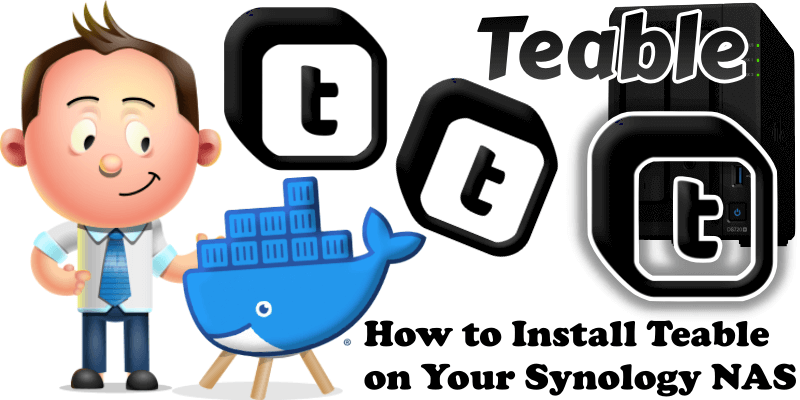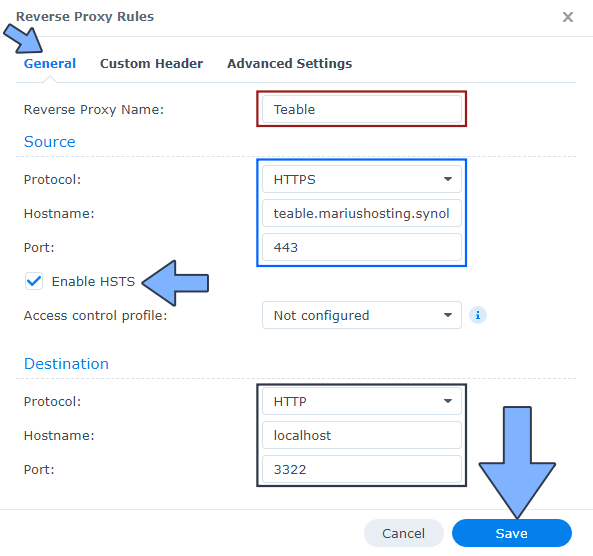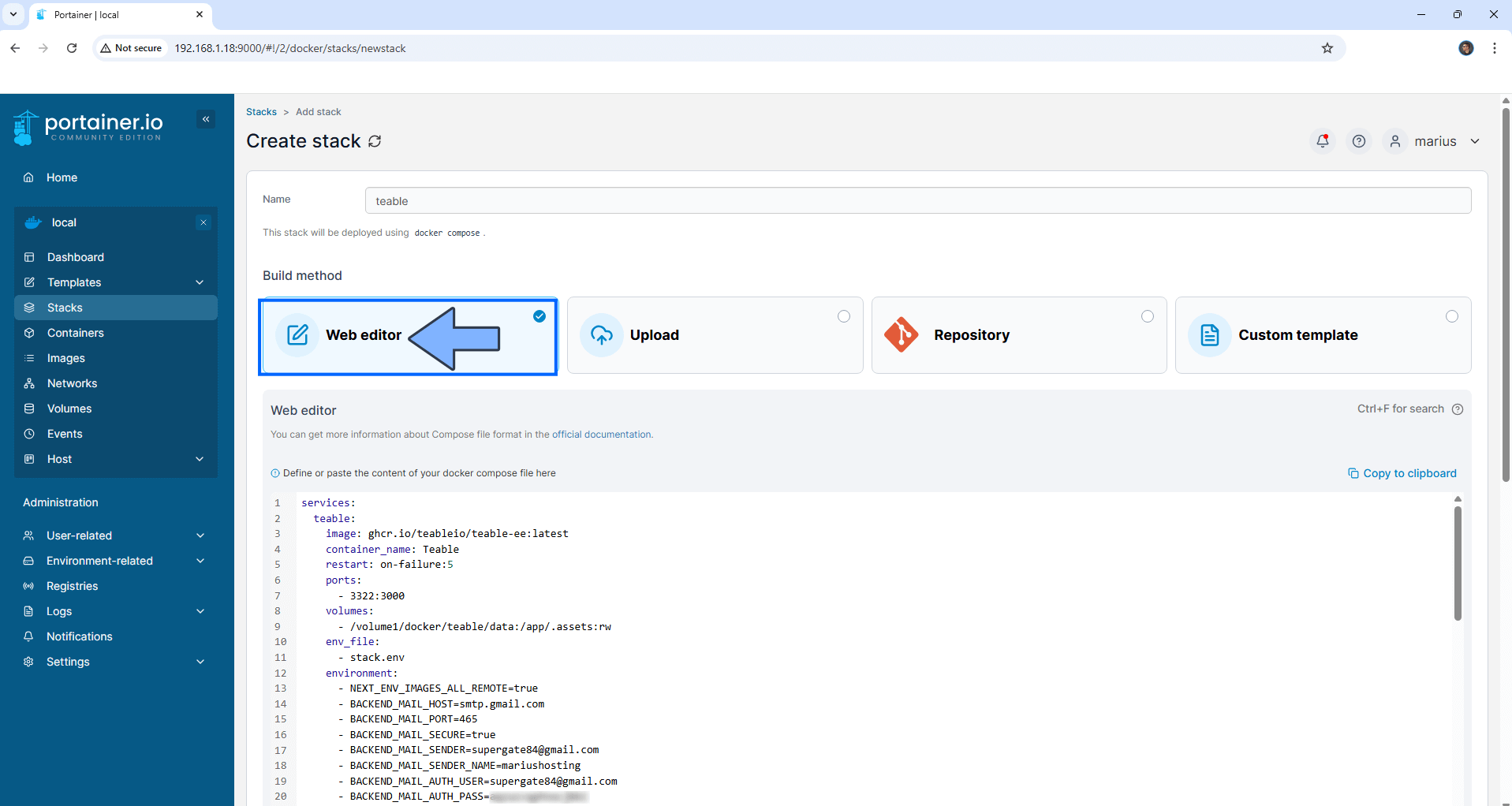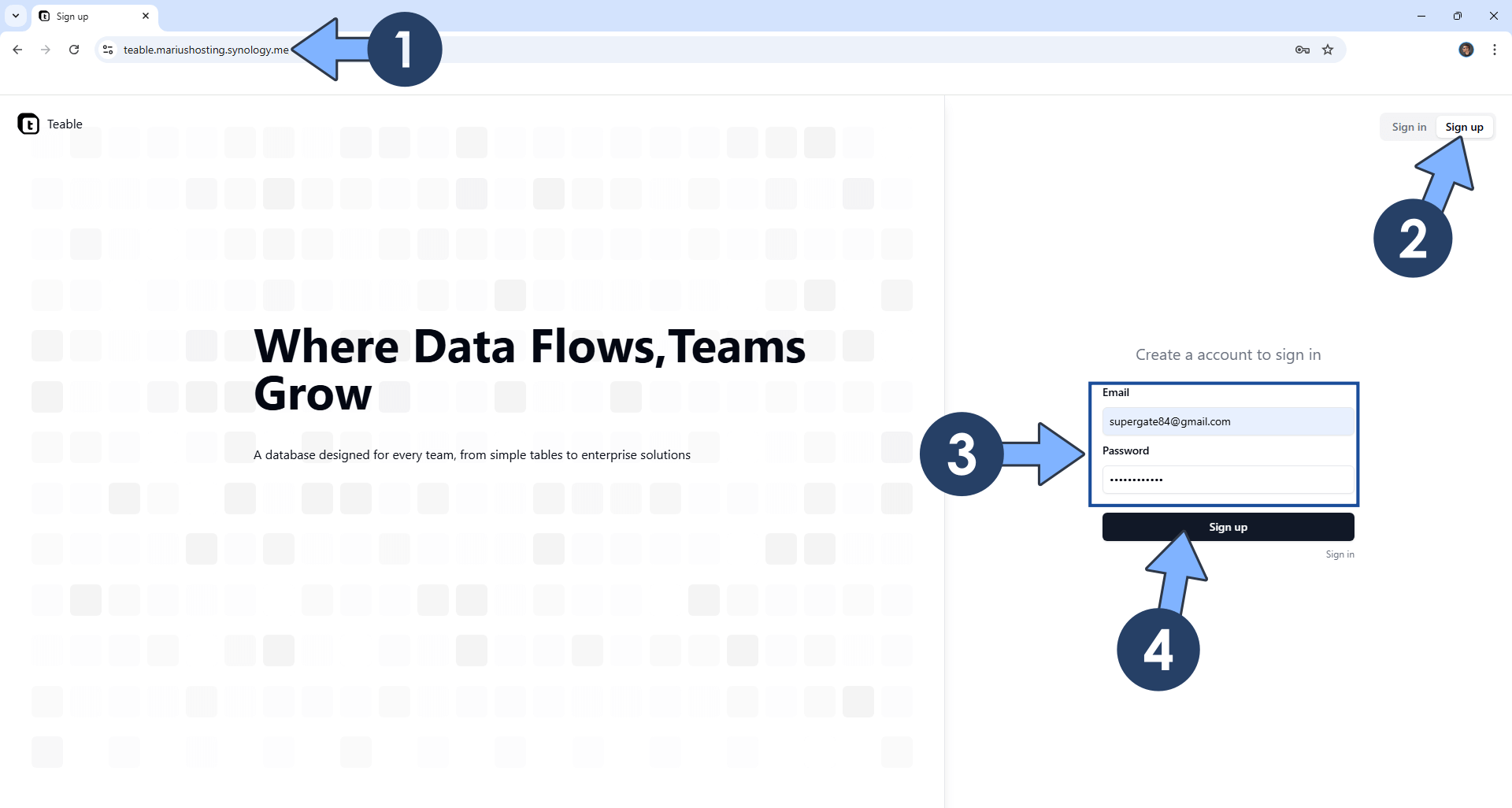
Teable is a super fast, real-time, professional, developer-friendly, no-code database built on PostgreSQL. It uses a simple, spreadsheet-like interface to create complex enterprise-level database applications. Unlock efficient app development with no code, free from data security and scalability hurdles. You can think of it as migrating the powerful capabilities of Airtable onto PostgreSQL while inheriting exceptional performance and stability from the physical databases. In this step by step guide I will show you how to install Teable on your Synology NAS using Docker & Portainer.
STEP 1
Please Support My work by Making a Donation.
STEP 2
Install Portainer using my step by step guide. If you already have Portainer installed on your Synology NAS, skip this STEP. Attention: Make sure you have installed the latest Portainer version.
STEP 3
Make sure you have a synology.me Wildcard Certificate. Follow my guide to get a Wildcard Certificate. If you already have a synology.me Wildcard certificate, skip this STEP.
STEP 4
Go to Control Panel / Login Portal / Advanced Tab / click Reverse Proxy. Follow the instructions in the image below.

STEP 5
Now click the “Create” button. Follow the instructions in the image below.

STEP 6
After you click the Create button, the window below will open. Follow the instructions in the image below.
On the General area, set the Reverse Proxy Name description: type in Teable. After that, add the following instructions:
Source:
Protocol: HTTPS
Hostname: teable.yourname.synology.me
Port: 443
Check Enable HSTS
Destination:
Protocol: HTTP
Hostname: localhost
Port: 3322

STEP 7
On the Reverse Proxy Rules click the Custom Header tab. Click Create and then, from the drop-down menu, click WebSocket. After you click on WebSocket, two Header Names and two Values will be automatically added. Click Save. Follow the instructions in the image below.

STEP 8
Go to Control Panel / Network / Connectivity tab/ Check Enable HTTP/2 then click Apply. Follow the instructions in the image below.

STEP 9
Go to Control Panel / Security / Advanced tab/ Check Enable HTTP Compression then click Apply. Follow the instructions in the image below.

STEP 10
Go to File Station and open the docker folder. Inside the docker folder, create one new folder and name it teable. Follow the instructions in the image below.
Note: Be careful to enter only lowercase, not uppercase letters.

STEP 11
Now create three new folders inside the teable folder that you created at STEP 10 and name them data, db, redis. Follow the instructions in the image below.
Note: Be careful to enter only lowercase, not uppercase letters.

STEP 12
Follow my step by step guide on how to activate SMTP for your Gmail account. This step is mandatory. Note: If you don’t want to use the easiest way for SMTP with Google and you already have SMTP details from your own Mail Server, you can just skip this STEP and use your personalized email SMTP details instead.
STEP 13
Log into Portainer using your username and password. On the left sidebar in Portainer, click on Home then Live connect. Follow the instructions in the image below.

On the left sidebar in Portainer, click on Stacks then + Add stack. Follow the instructions in the image below.

STEP 14
In the Name field type in teable. Follow the instructions in the image below.
services:
teable:
image: ghcr.io/teableio/teable-ee:latest
container_name: Teable
restart: on-failure:5
ports:
- 3322:3000
volumes:
- /volume1/docker/teable/data:/app/.assets:rw
env_file:
- stack.env
environment:
- NEXT_ENV_IMAGES_ALL_REMOTE=true
- BACKEND_MAIL_HOST=smtp.gmail.com
- BACKEND_MAIL_PORT=465
- BACKEND_MAIL_SECURE=true
- BACKEND_MAIL_SENDER=Your-own-gmail-address
- BACKEND_MAIL_SENDER_NAME=mariushosting
- BACKEND_MAIL_AUTH_USER=Your-own-gmail-address
- BACKEND_MAIL_AUTH_PASS=Your-own-app-password
networks:
- teable
depends_on:
teable-db-migrate:
condition: service_completed_successfully
teable-cache:
condition: service_healthy
healthcheck:
test: ['CMD', 'curl', '-f', 'http://localhost:3000/health']
start_period: 5s
interval: 5s
timeout: 3s
retries: 3
teable-db:
image: postgres:17
container_name: Teable-DB
restart: on-failure:5
volumes:
- /volume1/docker/teable/db:/var/lib/postgresql/data:rw
environment:
- POSTGRES_DB=teable
- POSTGRES_USER=teableuser
- POSTGRES_PASSWORD=teablepass
networks:
- teable
healthcheck:
test: ["CMD", "pg_isready", "-q", "-d", "teable", "-U", "teableuser"]
interval: 45s
timeout: 10s
retries: 10
teable-db-migrate:
image: ghcr.io/teableio/teable-db-migrate-ee:latest
container_name: Teable-MIGRATE
environment:
- PRISMA_DATABASE_URL=postgresql://teableuser:teablepass@teable-db:5432/teable
networks:
- teable
depends_on:
teable-db:
condition: service_healthy
teable-cache:
image: redis:7
container_name: Teable-REDIS
restart: on-failure:5
volumes:
- /volume1/docker/teable/redis:/data:rw
networks:
- teable
command: redis-server --appendonly yes --requirepass redispassenv
healthcheck:
test: ['CMD', 'redis-cli', '--raw', 'incr', 'ping']
interval: 10s
timeout: 3s
retries: 3
networks:
teable:
name: teable-network
Note: Before you paste the code above in the Web editor area below, change the value for BACKEND_MAIL_SENDER and type in your own Gmail address. STEP 12.
Note: Before you paste the code above in the Web editor area below, change the value for BACKEND_MAIL_SENDER_NAME and type in your own username. mariushosting is an example for a username.
Note: Before you paste the code above in the Web editor area below, change the value for BACKEND_MAIL_AUTH_USER and type in your own Gmail address. STEP 12.
Note: Before you paste the code above in the Web editor area below, change the value for BACKEND_MAIL_AUTH_PASS and type in your own Gmail app password. STEP 12.

STEP 15
Click the Upload button after Web editor. Download the stack.env file by clicking the blue link below and then upload it from your computer in the “Load variables from .env files“. Follow the instructions in the image below. 🔒Note: Support my work to unlock the password. You can use this password to download any file on mariushosting forever!

STEP 16
Note: On the Environment variables change the value for SECRET_KEY and add your own SECRET KEY. (Generate your own Random 64 length SECRET_KEY.)
Note: On the Environment variables change the value for PUBLIC_ORIGIN. Type in your own synology.me DDNS that you have previously created at STEP 6 with https at the beginning.

STEP 17
After you make the changes, click the Web editor button. Follow the instructions in the image below.

STEP 18
Scroll down on the page until you see a button named Deploy the stack. Click on it. Follow the instructions in the image below. The installation process can take up to a few minutes. It will depend on your Internet speed connection.

STEP 19
If everything goes right, you will see the following message at the top right of your screen: “Success Stack successfully deployed“.

STEP 20
Your Teable-MIGRATE container will be marked as exited. This is normal behavior for this container. Go straight to the next STEP.

STEP 21
🟢Please Support My work by Making a Donation. Almost 99,9% of the people that install something using my guides forget to support my work, or just ignore STEP 1. I’ve been very honest about this aspect of my work since the beginning: I don’t run any ADS, I don’t require subscriptions, paid or otherwise, I don’t collect IPs, emails, and I don’t have any referral links from Amazon or other merchants. I also don’t have any POP-UPs or COOKIES. I have repeatedly been told over the years how much I have contributed to the community. It’s something I love doing and have been honest about my passion since the beginning. But I also Need The Community to Support me Back to be able to continue doing this work.
STEP 22
Now open your browser and type in your HTTPS/SSL certificate like this https://teable.yourname.synology.me In my case it’s https://teable.mariushosting.synology.me If everything goes right, you will see the Teable Login page. At the top right of the page, click Sign up, then type in your own Email Address and Password. Click Sign up. Follow the instructions in the image below.

STEP 23
Your Teable dashboard at a glance! On the left sidebar, click on the user icon then Settings.

STEP 24
A new pop up window will open. Click My Settings then select the theme for the Teable app. Follow the instructions in the image below.

STEP 25
You can also disable user registration for Teable. On the left sidebar, click Admin Panel then Settings. Click to disable the “Allow creating new accounts” option. Follow the instructions in the image below.

STEP 26
Enjoy Teable with your Team!

Enjoy Teable!
If you encounter issues by using this container, make sure to check out the Common Docker issues article.
Note: Can I run Docker on my Synology NAS? See the supported models.
Note: How to Back Up Docker Containers on your Synology NAS.
Note: Find out how to update the Teable container with the latest image.
Note: How to Free Disk Space on Your NAS if You Run Docker.
Note: How to Schedule Start & Stop For Docker Containers.
Note: How to Activate Email Notifications.
Note: How to Add Access Control Profile on Your NAS.
Note: How to Change Docker Containers Restart Policy.
Note: How to Use Docker Containers With VPN.
Note: Convert Docker Run Into Docker Compose.
Note: How to Clean Docker.
Note: How to Clean Docker Automatically.
Note: Best Practices When Using Docker and DDNS.
Note: Some Docker Containers Need WebSocket.
Note: Find out the Best NAS Models For Docker.
Note: Activate Gmail SMTP For Docker Containers.
This post was updated on Tuesday / December 23rd, 2025 at 10:34 AM
